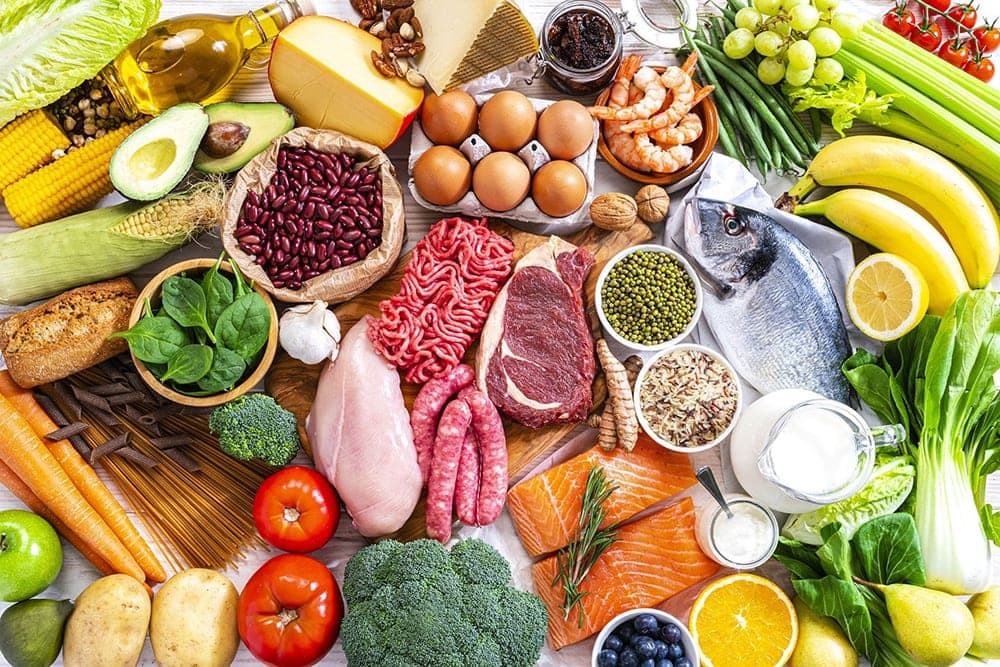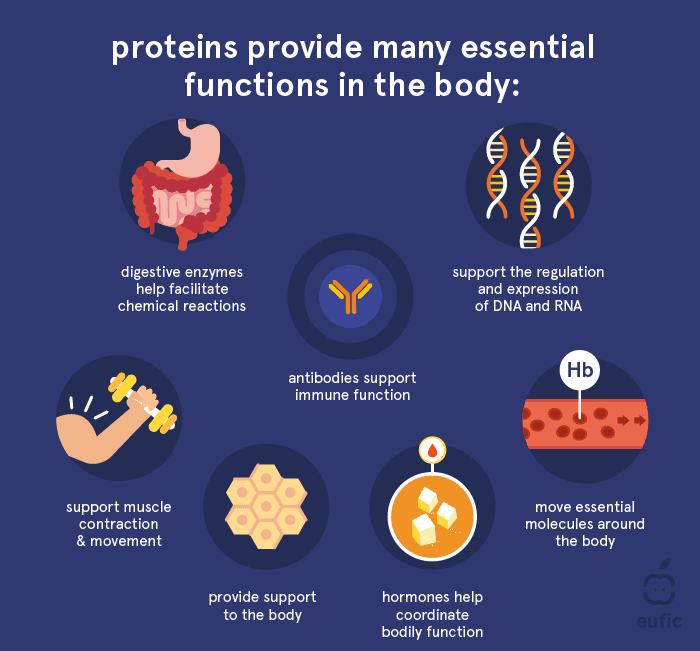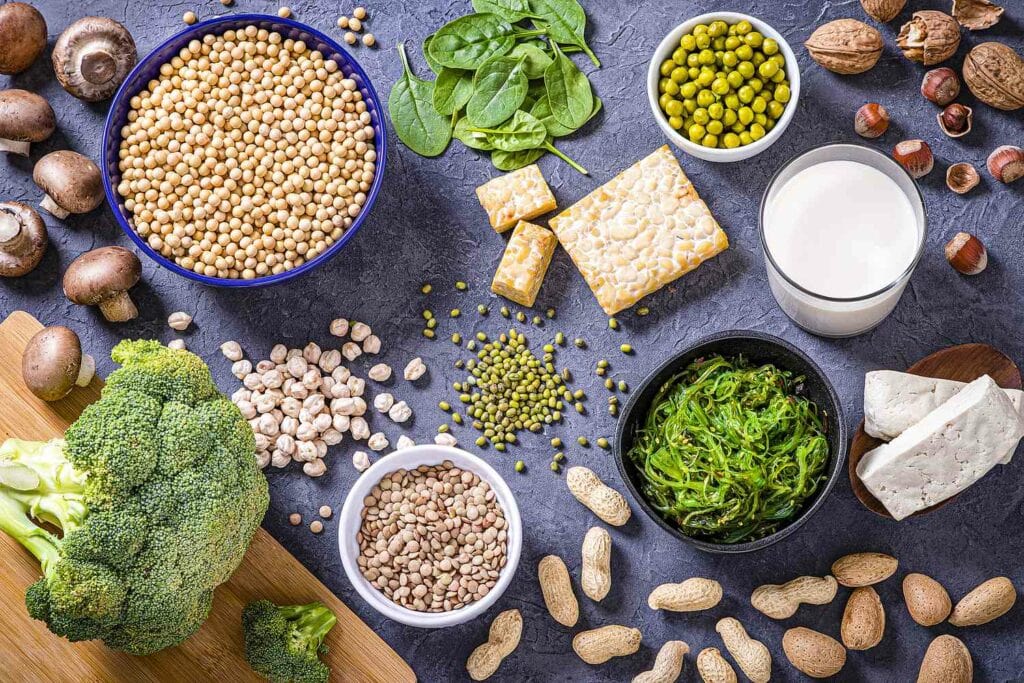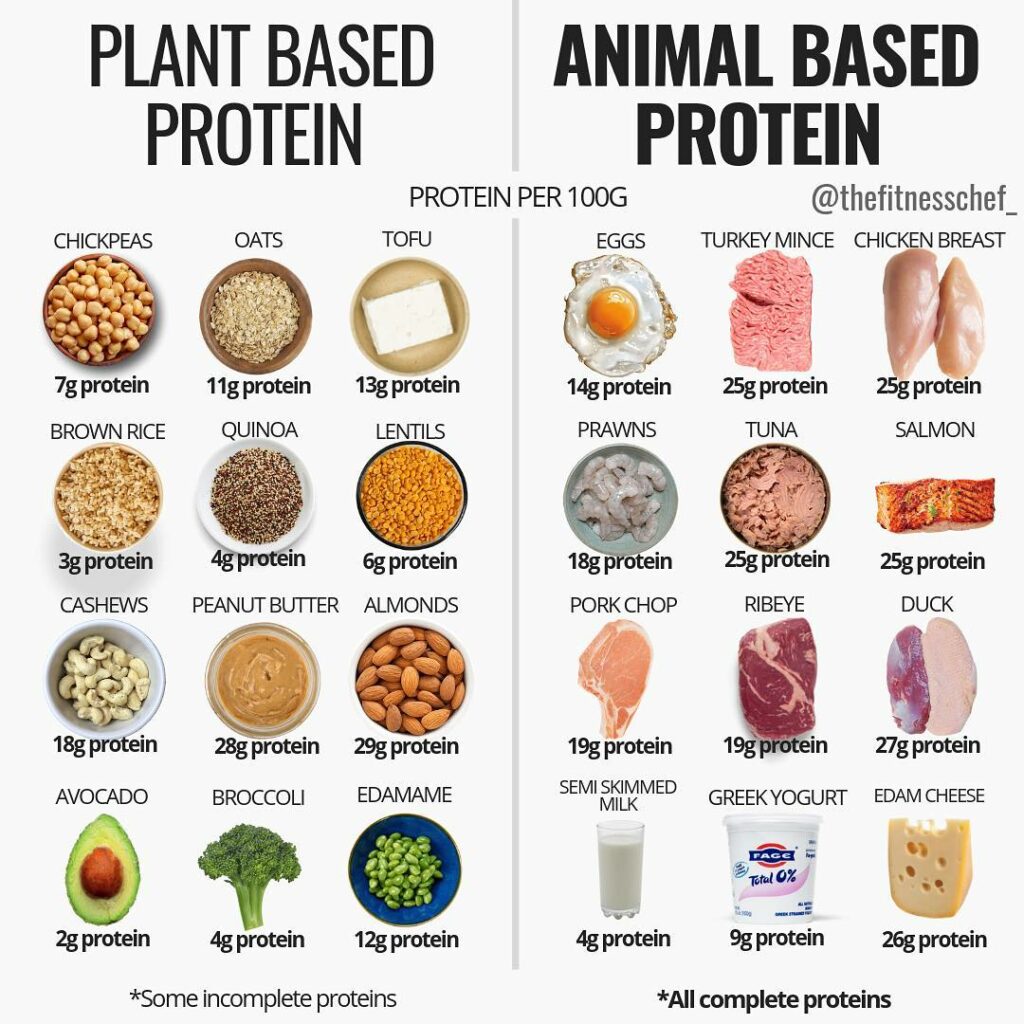What Is Protein & Why We Need It
This article is part of the 14-Day Healthy Kickstart Challenge and will introduce you to the macronutrient protein, why our bodies need it and how much you should consume. It will also list foods high in protein, including plant-based sources.

What Is Protein? Quick Summary!
Simply put, protein is a molecule made up of amino acids. It is one of three macronutrients, the others being carbohydrates and dietary fat, that provide us with energy and fuel in the form of calories. But it’s not the only function of protein!
Proteins are made up of many building blocks, known as amino acids. Our body needs dietary protein to supply amino acids for the growth and maintenance of our cells and tissues. Our dietary protein requirement changes throughout life.
Protein intake recommendation is typically 0.8 grams of protein per kilogram of body weight but it’s the minimum required to avoid deficiency. To take advantage of protein benefits, especially while trying to lose weight or build muscle, an intake of 1.5-2 grams per kiligram of body weight is more desirable.
Plant and animal-based proteins vary in their quality and digestibility, but this is not usually a concern for most people if their total protein meets their needs. We should aim to consume protein from a variety of sources that benefits both our health and the planet.

What Does Protein Do In The Body & Why Do We Need It?
The word protein comes from the Greek word “protos”, meaning the first element. It is found abundantly throughout the body – muscle, bone, skin, hair, you name it. The body uses protein on a daily basis to maintain, grow and repair all these tissues and it is an essential element for good functioning and structure of all living cells. This is why certain people – athletes, pregnant people, individuals recovering from surgery – need more protein.
Some proteins are enzymes and some are hormones. Enzymes in the body aid in all chemical reactions such as digestion, blood clotting, and muscle contraction. Hormones aid in cellular responses and organ function.
Moreover, proteins in the body provide rigidity to cells, help the body to stay at a healthy pH, balance fluids, aid in immunity, and transport and store nutrients.
Last but not least, like each macronutrient, protein provides the body with energy. Above all, this is why we eat, and likely a simple enough explanation for many.
In conclusion, proteins are working overtime in the body to keep all those moving parts doing just that – moving!
What Is Protein Synthesis?
In short, protein synthesis is the process in which protein converts into bits and pieces your body can utalize for various functions.
Proteins in our body are constantly being built and disposed of. After we eat, proteins are broken down by digestion into amino acids. Amino acids are then absorbed and used to make other proteins in the body. Adequate protein and energy intake, on a daily basis, ensures the cycle continues.
Protein synthesis relies on the nine essential amino acids which come exclusively from the food we eat. As a result of synthesis, enzymes are created and structural support is maintained in the body.
While this is all happening in the cells, it’s important to keep the bigger picture in mind. Every part of the body can be broken down to a cellular level, and this is why protein consumption is linked to better muscle mass and fat loss.
Ultimately, amino acids are the key component in this operation, but other factors such as resistance training may also contribute to musculoskeletal protein synthesis. This is why many people recommend timing a protein-dense meal after a weight-lifting session; depleted muscles need fuel to repair and replenish, and ingesting amino acids will stimulate this process (2).
Types Of Amino Acids
Proteins are made up of amino acids, and when combined in certain groups or orders, they result in different proteins. When we break it down to the tiniest parts of the system, our body does produce some amino acids, but we rely on the essential ones in the foods we eat.
Essential Amino Acids
There are 20 amino acids in total. There are nine essential amino acids that our body doesn’t naturally generate: histidine, isoleucine, leucine, lysine, methionine, phenylalanine, threonine, tryptophan, and valine.
Complete & Incomplete Proteins
While many foods contain protein, not every food is a complete protein. A complete protein will contain all nine essential amino acids. For example, meat, dairy, and eggs are complete proteins. This is true of all animal foods which should make it easy to remember.
On the other hand, foods such as nuts and seeds, grains, vegetables, and legumes are incomplete proteins. They will provide some amino acids, but not all of them. Within these broad food groups, there are some exceptions such as soy protein, amaranth, buckwheat, quinoa, hemp seeds, and chia seeds.
Benefits Of A Higher Protein Diet
It is rare that an adult would become genuinely protein deficient, but many adults are probably not eating nearly enough protein to feel satiated and to develop or maintain muscle mass.
While many children are indeed protein-deficient due to food insecurity which can cause developmental and growth impediments, it’s important to prioritise as we age as well.
First and foremost, protein is going to keep you fuller for longer. Most people have probably attempted dieting without success due to feeling hungry or finding themselves craving “forbidden” foods. With a focus on protein, we can virtually eliminate true hunger from sabotaging our best efforts.
That doesn’t mean we should eliminate carbs or we shouldn’t give in to our cravings here and there for our sanity. It does, however, mean that we can start by adding something in rather than taking something away to get on the right track.
Not only does protein satiate individuals in the short-term, but a focus on protein may help compliance which can improve markers for success in long-term weight loss and maintenance goals and increase lean body mass a.k.a. muscle (1).
Some additional science-backed benefits of a high-protein diet are “[the potential to] spare lean body mass during weight loss, promote weight management, enhance glycemic regulation, and increase intestinal calcium absorption, which may result in long-term improvements in bone health (3).”
Read More About Protein Benefits Here
How Much Protein Do I Need?
The Recommended Dietary Allowance (RDA) for protein is a modest 0.8 grams of protein per kilogram of body weight. This is merely the amount recommended to avoid protein deficiency! It’s not the optimum amount of protein required for proper satiation, reducing cravings, and triggering muscle protein synthesis (MPS).
If you want to reap the full benefits of protein when it comes to fat loss, building, and maintaining muscle mass, the more accurate number is 1.5-2 grams of protein per kilogram of body weight.
Other factors come into play such as your age. For example, older people tend to need more protein to trigger muscle protein synthesis.
Other factors include whether or not you’re pregnant or lactating and sports performance needs. In these instances, a common recommendation for gaining muscle is 2.2 grams of protein per kilogram (1 gram per pound) of body weight (4).
Let’s say you are a 50-year-old woman weighing 60 kg, your height is 165 cm, and you exercise 4-5 times per week. Your typical RDA for protein is 60 grams per day, but the more optimal number is actually 100-110 grams per day.
While research has not reached a definitive decision surrounding this very nuanced recommendation, we can reasonably conclude from various studies that 1.6 grams of protein per kilogram in “non-dieting” conditions (whether losing or gaining weight) can maximise muscle growth in conjunction with strength training (4).
With all of that said, this is why I’ve settled on around 100 grams of protein per day as our general challenge guideline. You can make it 120 grams for men.
You can use this calculator to see how much you need (look at the upper numbers).
How Much Protein Can Your Body Absorb?
Like with generalising protein recommendations, research has not made any definitive conclusions in terms of protein absorption either. However, we can make reasonable decisions for our goals with what we do know.
First, what happens to protein after we reach the absorption threshold?
Ultimately, any protein not readily being used will be oxidised. Some studies report that 20-25 grams of protein can be consumed before oxidation begins in the average person. This additional protein will subsequently be used for energy or otherwise converted to organic acids (for example, urea) (4).
In other words, you’ll be peeing the additional protein away. This is commonly understood about taking some supplements that can’t be used by the body in the form they’re being sold.
With this in mind, we can reasonably aim to eat 0.4 grams of protein per kilogram of body weight per meal. For example, a 68-kilogram (150-pound) individual would eat 27 grams of protein per meal with confidence that the amino acids will be absorbed efficiently.
What Are The Best Sources Of Protein?
The best sources of protein can be determined by several factors including what other nutrients protein is paired with during consumption and the timing of the protein intake.
Ultimately, the best protein sources will be complete protein sources. As a reminder, these proteins contain all of the essential amino acids.
With that in mind, animal protein often takes the cake as the cream of the crop when it comes to protein. This includes eggs, milk, meat, poultry, and seafood. This has been studied in the general population as well as in pregnant women and elderly people. Animal protein consumption has been linked to healthy birth weights, better protein synthesis, and more substantial lean body mass (6).
When it comes to protein supplements – namely powders or bars – whey reigns supreme. This is because it’s a simple ingredient derived from an animal source. They are rich in both essential and branch chain amino acids so the bioavailability of protein from a whey source is superior to that of most plant-based protein supplements (6). When looking for a whey supplement, concentrates may provide more benefits due to less denaturation during processing.
Consuming plant-based protein will allow you to reduce intake of saturated fat and dietary cholesterol intake (if those are of concern) and will address some sustainability concerns.
Some plant protein choices are better than others. As discussed previously, fruits and vegetables won’t solely provide you with the protein you need. On the other hand, foods like soy – tofu, tempeh, textured vegetable protein, edamame, soy milk/protein powder or quinoa – are in and of themselves complete with the essential amino acids making it a good choice.
Plant proteins often have additional benefits such as a higher fibre content and phytochemicals which can lend themselves well to a balanced diet with a variety of nutrients from a variety of sources which is what we want to achieve in the long run.
More On Plant-Based Protein
Elaborating further on complete and incomplete proteins, let’s investigate what makes a plant protein source a good one.
As I mentioned before, soy, amaranth, quinoa, hemp seeds, and chia seeds are complete sources of plant-based protein. One of the biggest problems you may run into here is that eating a substantial amount of something like hemp seeds is unlikely. This is why many vegetarians and vegans are relying very heavily on soy.
Unlike animal protein, each plant protein contains a different set of amino acids so the key to getting all essential ones in a meal is by protein combining.
- Grains/Cereals + Legumes = complete protein
- Legumes + Nuts/Seeds = complete protein
- Grains/Cereals + Nuts/Seeds= Almost complete, missing lysine
- Dairy or Eggs + Grains or Legumes or Nuts/Seeds = Complete protein
For example, if you’re only choosing something like black beans as your protein source for dinner, you won’t be getting all the essential amino acids. But, add some rice to the dish and you have a complete protein set.
Other examples of complete plant protein combos:
- Whole grain toast with peanut butter
- Hummus – a combination of chickpeas and tahini (seeds)
- Beans and rice
- Spinach and sunflower seeds
- Lentils and whole grain bread
- Pasta and peas
- Corn tortillas and beans
The list could go on indefinitely with different food combinations. The key in managing protein intake as a plant-based eater is to focus on a variety of foods. Pulling from different protein and whole grain sources will likely hit all your needs. With the increase in availability of meat substitutes which are typically complete proteins, it’s not difficult to feel satisfied and satiated.
More: Complete Proteins Combinations + Charts

Do Vegetables & Fruit Contain Protein?
Fruit and vegetables do contain protein, although usually their protein content would be considered a trace amount. Moreover, not all fruits and vegetables contain protein. Most fruits and vegetables are primarily a source of carbohydrates with some exceptions – like avocado – containing primarily fat.
When prioritising protein intake, it’s much more effective to focus on complete protein sources such as animal and plant protein such as soy or pea protein. These foods will contain mostly protein with some fat and few carbohydrates.
Again, these proteins contain all the essential amino acids and are more bioavailable for their functions in the body. Boosting protein intake with some trace amounts from fruit and vegetables can be great, though – especially when you’re trying to hit a certain protein number.
Some high-protein fruits and vegetables include:
- Brussels sprouts (1 cup cooked, 3 grams protein)
- Potatoes (1 baked potato, 4 grams protein)
- Asparagus (1 cup, 4.5 grams protein)
- Broccoli (1 cup, 2.5 grams protein)
- Avocado (1 medium avocado, 3 grams protein)
- Passionfruit (1 cup, 5.2 grams protein)
- Guava (1 cup, 4.2 grams protein)
- Apricots (1 cup, 2.2 grams protein)
- Mushrooms (1 cup raw slices, 2.1 grams protein)
- Kiwi (1 cup, 2.1 grams protein)
Edamame and green peas – technically legumes – are high-protein foods that some may consider a vegetable. Corn – technically a grain – also contains some protein at 3 grams per cob.
These are some of the highest protein plant foods besides legumes, grains, seeds, and nuts. While they are excellent to add into the diet, the primary reasons would be micronutrients (vitamins and minerals), complex sugar intake to boost energy, and to increase fibre intake.
Top 50 Foods High In Protein
Looking for ideas to boost your protein intake? This is a list of the highest protein foods considering common serving sizes. Keep in mind that some sources of protein – such as a chicken leg with skin – are often larger serving sizes and also contain a substantial amount of fat. This is neither good nor bad, just something to consider, especially if tracking calories.
Lean meats such as ground turkey or chicken breast will contain plenty of protein and less fat than other sources which may necessitate larger serving sizes to accommodate your own needs. You should also take into consideration the serving size when measuring from raw or cooked.
Unless otherwise specified, the foods in this list are based on cooked weight and protein content.
Animal Protein Sources:
- Roasted chicken leg (whole with skin, 62 grams of protein)
- Lamb shoulder roast, cooked (170 g/6 oz., 60.4 grams of protein)
- Chicken breast (170 g/ 6 oz., 54.5 grams)
- Lean ground turkey (170 g / 6 oz., 53.9 grams)
- Lean pork chop (170 g/ 6 oz., 52.7 grams)
- Turkey breast, roasted (170 g/ 6 oz., 51.2 grams)
- Pork tenderloin (170 g/ 6 oz., 50.8 grams)
- Bluefin tuna (170 g/ 6 oz., 50.8 grams)
- Grouper (170 g/ 6 oz., 50.2 grams)
- Yellowfin tuna (170 g/ 6 oz., 49.6 grams)
- Skirt steak (170 g/ 6 oz., 48.7 grams)
- Roasted chicken leg (skinless, 48.2 grams)
- Coho salmon (170 g/ 6 oz., 46.5 grams)
- Chuck steak (170 g/ 6 oz., 47 grams)
- Kielbasa sausage (1 link, 45.7 grams)
- Sockeye salmon (170 g/ 6 oz., 45 grams)
- Lean ground beef (170 g/ 6 oz., 44.8 grams)
- Snapper (170 g/ 6 oz., 44.7 grams)
- Tilapia (170 g/ 6 oz., 44.5 grams)
- Ground pork (170 g/ 6 oz., 43.7 grams)
- Yellowtail (170 g/ 6 oz., 43.3 grams)
- Wild Atlantic salmon (170 g/ 6 oz., 43.2 grams)
- Northern pike (170 g/ 6 oz., 42 grams)
- Cod (170 g/ 6 oz., 41.1 grams)
- Mackerel (170 g/ 6 oz., 40.5 grams)
- Lean ham, roasted (1 cup, 39.7 grams)
- Mahimahi (1 fillet, 37.7 grams)
- Eel (1 fillet, 37.6 grams)
- Sardines, canned (1 cup, 36.7 grams)
- Roast duck (1 cup, 32.9 grams)
- Lamb chops/cutlets (2 small chops, 32.5 grams)
- Trout (1 fillet, 32.8 grams)
- Chicken thigh (31.9 grams)
- Smoked whitefish (1 cup, 31.8 grams)
- Haddock (1 fillet, 30 grams)
- Cooked prawns/shrimp (1 cup, 29 grams)
- Ribeye steak (113 g / 4 oz., 28 grams)
- Ling, white fish ( 150 g / 5 oz., 27 grams)
- Whey protein powder (1 standard scoop, 25 grams)
- Greek yoghurt, fat-free (1 cup, 23 grams)
- Cooked mussels (1 cup, 20 grams)
- Milk, skim/low-fat (1 cup, 16.5 grams)
- Milk, whole (15.4 grams)
- Cottage cheese, low-fat (½ cup, 14.1 grams)
- Yoghurt, non-fat (1 cup, 14 grams)
- Cheddar cheese, sliced ( 2 slices, 50 g / 2 oz., 13 grams)
- Parmesan cheese, grated (¼ cup, 10.4 grams)
- Mozzarella cheese (28 g / 1 oz., 9 grams)
- Smoked salmon (50 grams / 2 oz., 9 grams)
- Egg (1 large, 7 grams)
Plant Protein Sources
- Tofu, raw (1 cup, 43.5 grams)
- Edamame, boiled soybeans (1 cup, 31.3 grams)
- Oats, raw (1 cup, 26.3 grams)
- Fava beans (100 grams / 3.5 oz, 26.1 grams)
- Lentils (100 grams / 3.5 oz, 25.8 grams)
- Soy protein powder (1 standard scoop, 25 grams)
- Split peas (100 grams / 3.5 oz, 24.5 grams)
- Red lentil pasta, uncooked, e.g.San Remo (100 grams, 23 grams)
- Chickpeas (100 grams / 3.5 oz, 19.3 grams)
- Pumpkin seeds (¼ cup, 10 grams)
- Sunflower seeds (¼ cup, 9 grams)
- Quinoa (1 cup, 8 grams)
- Soy milk (1 cup, 8 grams)
- Green peas, frozen (1 cup, 7.2 grams)
- Almonds (¼ cup, 7 grams)
- Peanut butter (2 tbsp., 7 grams)
- Almond butter (2 tbsp., 6.7 grams)
- Buckwheat (1 cup, 6 grams)
- Hemp seeds (2 tbsp., 6 grams)
- Chia seeds (2 tbsp., 4 grams)
- Brown rice (1 cup, 5 grams)

Protein Intake Caveats
With the rising popularity in high-protein diets, influencer nutrition advice and coaching, and bodybuilding in general, we run the risk of having too much of a good thing.
When an individual consumes an excess of protein, they predominantly run the risk of hypercalciuria which essentially means they are losing calcium due to the tax on the kidneys. This can lead to bone degradation over time (5). The liver may also be adversely affected.
The protein recommendations here are based on what the body can absorb because most negative side effects can be chalked up to a lack of absorption.
All things considered, protein overconsumption isn’t something the average person should be concerned with. People with kidney disease may want to err on the side of caution. People who regularly train with weights and those who are ageing may want to err on the side of eating more protein.
Focusing on meeting your protein goals with real foods instead of protein supplements will also improve absorption rates. Finally, focusing on managing fat and carbohydrate intake and overall eating a balanced diet will generally keep diet-related health concerns at bay.
SOURCES
- https://academic.oup.com/ajcn/article/87/5/1558S/4650426
- https://nutritionandmetabolism.biomedcentral.com/articles/10.1186/1743-7075-9-40
- https://pubmed.ncbi.nlm.nih.gov/25757894/
- https://www.ncbi.nlm.nih.gov/pmc/articles/PMC5828430/
- https://www.ncbi.nlm.nih.gov/pmc/articles/PMC4045293/
- https://www.ncbi.nlm.nih.gov/pmc/articles/PMC3905294/
